Asset Discovery
Last Updated: 2025-05-27
Purpose
This article describes the Asset Discovery feature.
Introduction
Asset Discovery is a critical component of Outpost24's security platform, enabling organizations to identify and catalog all hardware and software assets within their network infrastructure. By performing automated scans using protocols like ARP, ICMP, TCP, and UDP, Asset Discovery provides a comprehensive inventory of devices, applications, and services. This comprehensive view is essential for setting up effective vulnerability scanning and risk management processes. Whether it's discovering Docker images in a registry or enumerating networked devices, Asset Discovery ensures that all assets are accounted for, facilitating more accurate assessments and informed decision-making in securing the IT environment.
Asset Discovery enumerate the hardware and software assets within an organization's network infrastructure. The goal of Asset Discovery is to provide a comprehensive view of an organization's IT assets to be used when setting up the Vulnerability Scanning.
Asset Discovery is an essential component of network security and risk management, and is performed with the help of automated tools that scan an organization's network to provide a detailed report of all detected assets.
Docker Image Discovery
A Docker image is a file used to execute code in a Docker container. Docker images act as a set of instructions to build a Docker container, like a template. Docker images also act as the starting point when using Docker. An image is comparable to a snapshot in virtual machine (VM) environments.
Docker Image Discovery enumerates docker images within a registry using provided credentials and the Docker Registry HTTP API V2.
Prerequisite
Prior to running a Docker discovery, make sure you have created the Docker credentials.
Running the Scan
A Docker Registry discovery function retrieves image information from a private Docker Registry such as name, OS, architecture and size.
The discovery will only find Docker images with the latest tag to limit the number of Docker images and improve visibility.
To perform a Docker discovery:
Navigate to Configurations > Scan Configurations in the Main Menu.
Click on the
 icon in the bottom right corner.
icon in the bottom right corner.Select Docker image discovery.
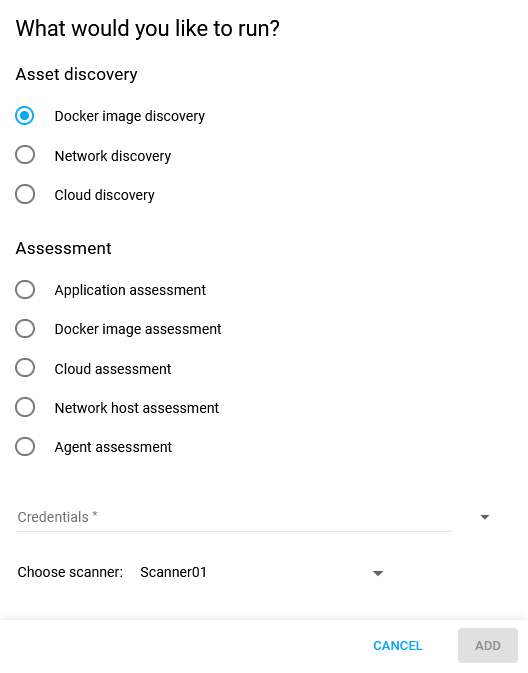
Fill in the required information.
Select a scanner.
Click on ADD to save the newly created configuration.
Select the Scan configuration and click on the scan now
 icon in the blue toolbar at the bottom right to run a Docker image discovery scan.
icon in the blue toolbar at the bottom right to run a Docker image discovery scan.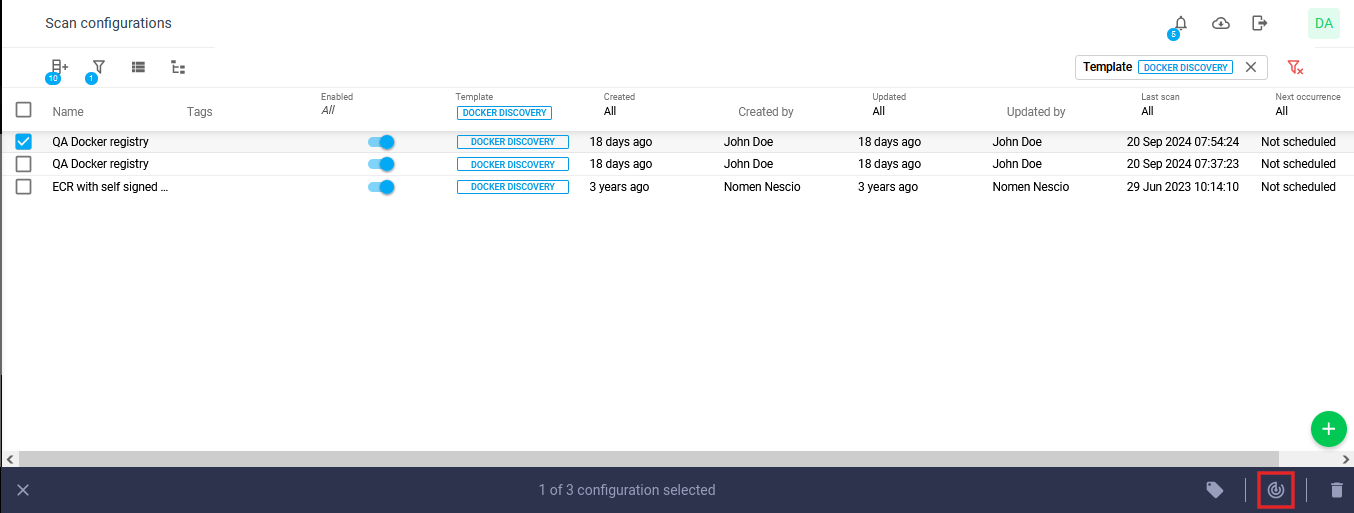
View the scan status under Scans in the Main Menu.
View the discovered assets, Docker images under Assets. They are shown in the list of assets with the filter 'source' set to Cloudsec, and the type set to Docker Image.
.png?inst-v=2c8e37f5-f79c-4f3d-a906-1db1caac66d9)
Network Discovery
A Network Discovery scan identifies and lists all the hardware and software assets within an organization's network infrastructure by sending packets over multiple protocols such as ARP/ICMP/TCP/UDP. If the scanner gets anything back from the target, the target is confirmed to be alive.
Setting up a Network Discovery Scan
To configure a Network discovery scan:
Select the Network discovery radio button.
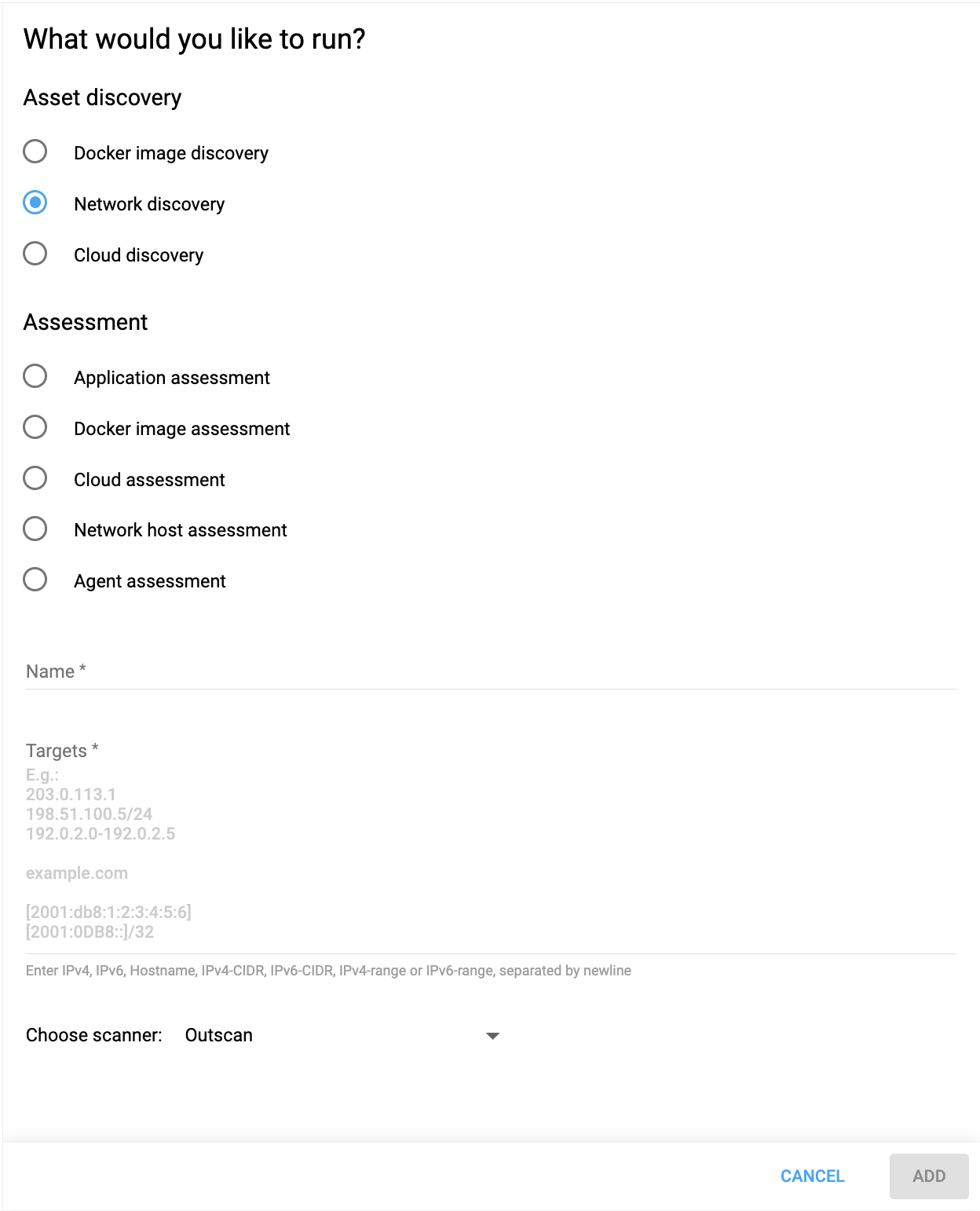
Enter a Name for the configuration.
Enter Targets for the configuration. These can be in the format of IPv4, IPv6, Hostname, IPv4-CIDR , IPv4-range, separated by newline.
Choose a scanner from the drop-down menu.
Click the ADD button to save the configuration.
Setting Ports Manually
Ports can be manually set to a saved network discovery scan
Open a previously saved discovery scan by clicking on it.
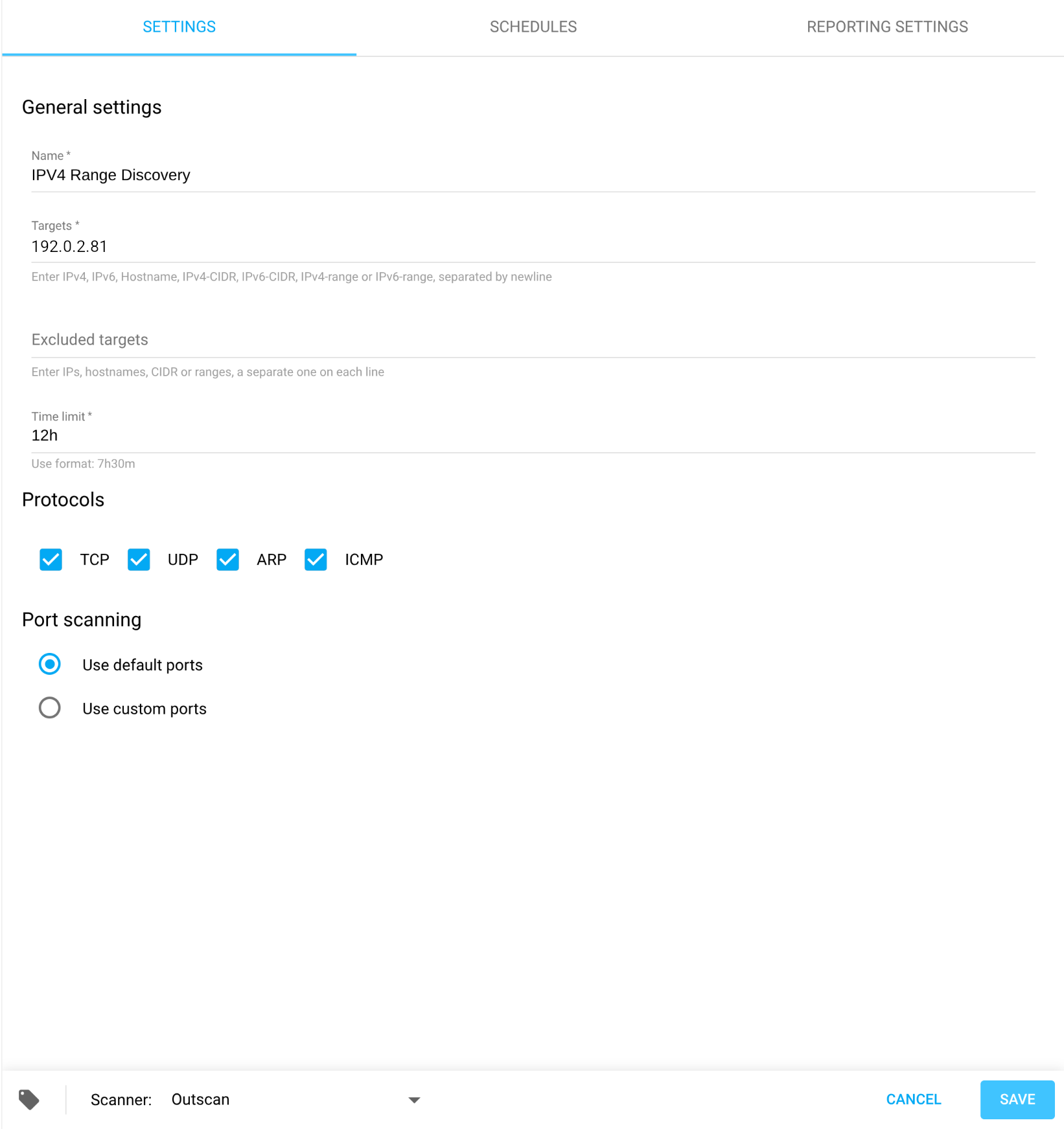
Go to the Port scanning section at the bottom.
Fill in the ports you want to scan. The port range expression format accept comma separated items such as a port (22,25), a range (20-80), an exclusion (!25565), default range (def), or no ports should be scanned (none).

Reporting Settings - Packet filter
In the Discovery Scan Settings UI, you can deselect a specific protocol that you do not want to trigger. However, this only stops explicitly sending requests with those protocols, it does not prevent it from triggering on related traffic. This may lead to seeing targets trigger on protocols that are deselected in the UI.
With the advanced report filtering option, you can perform a discovery scan but ignore traffic matching the filter by adding Berkeley Packet Filter (BPF) expressions.

BPF Expression Syntax
Refer to https://biot.com/capstats/bpf.html [1] for syntax.
Use Cases
Sometimes, even if you do not send an Address Resolution Protocol (ARP) message, you may still get an ARP response which marks the target as alive. By setting a filter to remove the ARP messages, the scanner will not report on ARP responses.
Examples
Example 1
Scan results without packet filter.
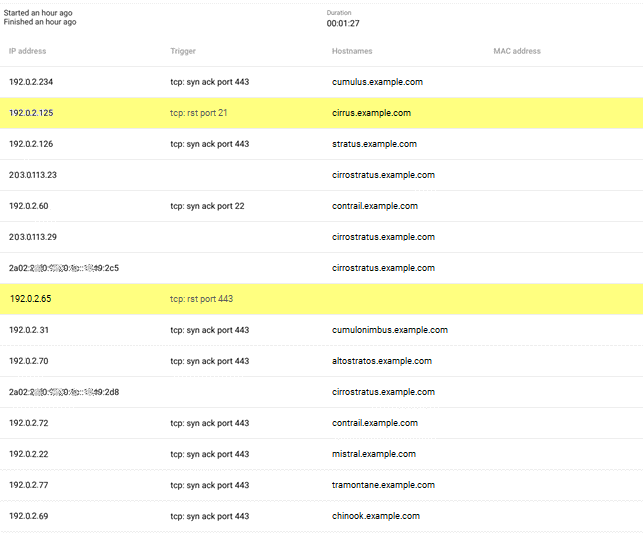
Example 2
Scan results using the packet filter to filter out TCP RST packets “tcp[13] & 0x04 != 0”
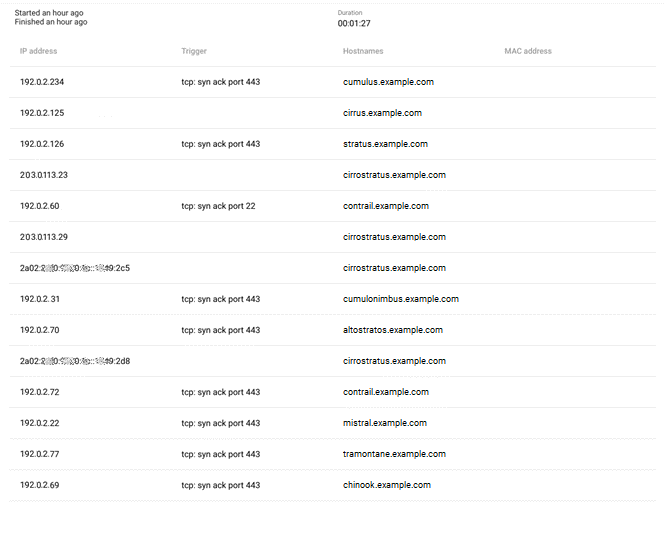
Example 3
Scan results using the packet filter to capture TCP RST packets “not (tcp[13] & 0x04 != 0)”

Additional Resources
Cloud Discovery
A Cloud Discovery scan counts the instances in (AWS currently) cloud environments without using network traffic but with provided AWS credentials and querying the AWS REST APIs.
Run the Cloud Discovery Scan
To configure a Cloud discovery scan:
Navigate to Configurations > Scan Configurations in the Main Menu.
Click on the
 icon in the right bottom corner.
icon in the right bottom corner.Select Cloud discovery.
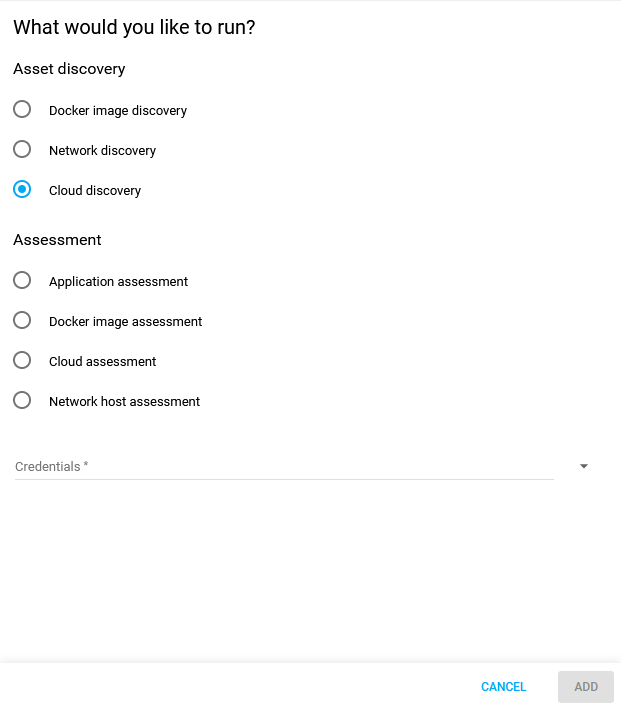
Select Credentials from the drop-down menu.
Select Regions.

Choose a scanner.
Click the blue ADD button to save the configuration.
Select the Scan configuration and click on the scan now
icon in the blue toolbar at the bottom right to run a Cloud discovery scan.
View the scan status under Scans in the Main Menu.

View the discovered assets, Docker images under Assets > Assets as the list of assets with the filter 'source' set to Cloudsec and the type set to Docker Image.
.png?inst-v=2c8e37f5-f79c-4f3d-a906-1db1caac66d9)
Discovery Tagging
When configuring a discovery scan it is possible to set tags that are applied to the found assets, there are two different ways the tags can be applied.
The tags given in Add the following tags to discovered assets is added to all discovered assets.
The tags given in Set the following tags to only exist on discovered assets is removed from all assets, and added to all assets found by the discovery.

This will remove that tag from all assets you have, so make sure to not do this for tags you want to be using across different configurations.
Related Articles
- Installing a macOS Agent
- Removing an Agent from Linux
- Check Connectivity to Agent Server
- Asset Discovery
- Agent Latest Version
- Using the Agent Info Command
- Setting Up an Agent Using System Proxy
- Agent Call Home
- Assets
- Checking if Agent is Running
- Removing an Agent from Windows
- Installing a Windows Agent
- Agent Installation Introduction
- Installing a Linux Agent
- Managing Agents
Copyright
© 2026 Outpost24® All rights reserved. This document may only be redistributed unedited and unaltered. This document may be cited and referenced only if clearly crediting Outpost24® and this document as the source. Any other reproduction and redistribution in print or electronically is strictly prohibited without explicit permission.
Trademark
Outpost24® and OUTSCAN™ are trademarks of Outpost24® and its affiliated companies. All other brand names, product names or trademarks belong to their respective owners.
